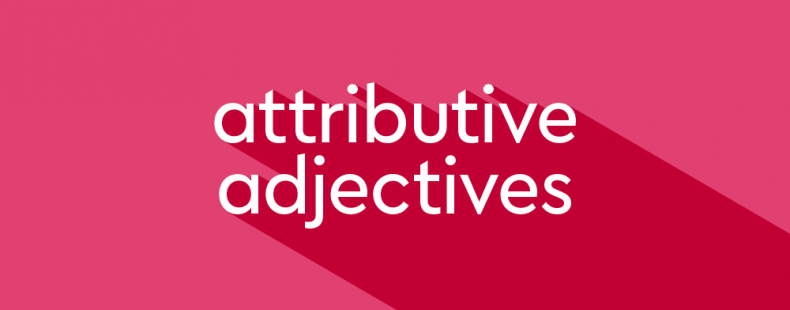Grammar experts know that adjectives are words that we use to modify and describe nouns and pronouns. And if you know your adjectives, you know that they are usually comfortable sitting right next to their beloved nouns and pronouns. But did you know that there is a special name for the type of adjective that is located right beside its best noun or pronoun friend? This type of adjective is called an attributive adjective, and it never lets a linking verb get between it and the word it modifies.

What is an attributive adjective?
An attributive adjective is an adjective that is directly adjacent to the noun or pronoun it modifies. An attributive adjective is not separated from a noun by a linking verb.
In English, attributive adjectives usually come directly before the noun they modify. For example:
- She has a small car.
- He has some delicious pies.
However, it is possible for attributive adjectives to be used postpositively, meaning they come after the noun or pronoun they modify. For example,
- I got my mom something special.
- Usain is the fastest man alive.
In either case, attributive adjectives are part of the same noun phrase as the word they modify. If an adjective is separated from the word it modifies by a linking verb, it is not an attributive adjective. Instead, we refer to this kind of adjective as a predicate adjective. For example,
- Attributive adjective: I laughed at the funny clown.
- Predicate adjective: The clown is funny.
Learn about linking verbs and the difference they make between attributive and predicate adjectives.
Where do you include an attributive adjective in a sentence?
Attributive adjectives are part of the same noun phrase as the noun or pronoun they modify. In practice, this means that attributive adjectives come directly before or, less commonly, immediately after the word that they modify. If an adjective is part of the predicate, meaning it is a predicate adjective, then it is not an attributive adjective.
- Attributive adjective used with a subject: Purple flowers are my favorite.
- Attributive adjective used with an object: Peter picked purple flowers.
- Not an attributive adjective: The flowers are purple.
Attributive adjective examples in a sentence
The following sentences show the different ways we can use attributive adjectives. You will notice that no matter how we use them, they are always right next to the noun or pronoun that they modify.
Example #1
- Emir loves spicy food. (The attributive adjective spicy modifies the noun food.)
Example #2
- Silly, spunky simians smiled at Simon. (The attributive adjectives silly and spunky modify the noun simians.)
Example #3
- I thought Paula was waiting for Rick, but she said she was expecting someone else. (The attributive adjective else modifies the pronoun someone.)
Attributive adjective rules & best practices
In general, we usually place attributive adjectives directly before the nouns or pronouns that they modify. For example, we would say I bought green apples and not “I bought apples green.”
When using attributive adjectives, we often follow a particular adjective order. For example, we say I bought two new jackets rather than “I bought new two jackets.” If you need to brush up on adjective order, you can take a look at our handy guide on the subject.
However, there are times when it is grammatically correct to place an attributive adjective after a noun. A common instance where we do this is when we use superlative adjectives to modify a noun/pronoun. An attributive adjective is placed after the noun for additional emphasis:
- We bought the newest car available.
- They took the fastest route possible.
- She finished her work in the slowest way imaginable.
Go more in depth on the topic of superlative adjectives.
Attributive adjectives are also often used after indefinite pronouns:
- I want to try something new.
- Put this money somewhere safe.
- We need to leave sometime soon.
For most adjectives, it is possible to use them either as attributive adjectives or predicate adjectives. However, some adjectives don’t make grammatical sense when used as an attributive adjective. Many of these adjectives begin with “a” as in alive, afraid, alone, and asleep. For example, you are more likely to hear someone say The children were asleep than “The asleep children were in their beds.”
All the adjectives, none of the errors
We’ve got an adjective for you: smart! And that’s what you’ll be when you check your writing on Thesaurus.com’s Grammar Coach™. This writing tool uses machine learning technology uniquely designed to catch grammar and spelling errors. Its Synonym Swap will find the best nouns, adjectives, and more to help say what you really mean, guiding you toward clearer, stronger, writing.













